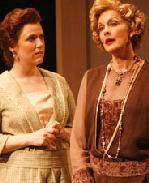SITE GUIDE
SEARCH
REVIEWS
FEATURES
NEWS
Etcetera and
Short Term Listings
LISTINGS
Broadway
Off-Broadway
NYC Restaurants
BOOKS and CDs
OTHER PLACES
Berkshires
London
California
New Jersey
DC
Philadelphia
Elsewhere
QUOTES
TKTS
PLAYWRIGHTS' ALBUMS
LETTERS TO EDITOR
FILM
LINKS
MISCELLANEOUS
Free Updates
Masthead
Writing for Us
A CurtainUp Review
The Dark at the Top of the Stairs
By Elyse Sommer
|
What's wrong?—Cora How do I know what's wrong? How does anyone ever know what's wrong— Lottie, trying to explain the inexplicable darkness beneath the surface of what her sister always viewed as a perfect marriage, unlike her own more obviously problematic family situation |

Donna Lynne Champlin and Michele Pawk
in The Dark at the Top of the Stairs
(Photo: Carol Rosegg)
|
Now Cummings has taken another step towards restoring William Inge to his rightful place alongside Tennessee Williams and Arthur Miller, by mounting a fine revival of The Dark at the Top of the Stairs. Unlike the little known one-acts of Requiem for William, this was the last of Inge's four Broadway hits (Picnic, Come Back Little Sheba, Bus Stop), all of which were made into films.
Actually Dark. . . was reworked from Further Off From Heaven, the very first play Inge wrote in 1945. That early version had a very brief life in a Dallas theater but was well enough received to encourage Inge to keep writing and by the time it was rewritten and re-titled Inge was a hot enough playwright to attract a director like Elia Kazan and big name actors like Pat Hingle and Teresa Wright to play Ralph and Cora Floyd and Eileen Heckart to play her blowsy, outspoken older sister Lottie. (The cast makes the much less subtle film worth seeing—Robert Preston, Dorothy McGuire and Eve Arden, also Shirley Knight as young Reenie Flood and Angela Lansbury as Mavis Pruitt who's mentioned but never seen in the play).
While the film version departed from the original script, the Transport Group revival is true to the Inge script: The story is set in a small town near Oklahoma City in 1923 where oil is making a lot of people suddenly rich and the automobile is rapidly making the harnesses Rubin Flood sells obsolete. The Flood marriage is in no better shape even though it began as an instant and passionate romance when Cora was only seventeen and Rubin, at that time still a rancher, came riding down the street "like a picture of Sin" (at least that's how her sister Lottie recalls the meeting that led to a hasty have-to wedding shortly thereafter). Their marital tensions are caused chiefly by Rubin's traveling salesman job, which leaves Cora lonely and over-involved with her children and worrying about temptations he encounters on the road. His typical for the times inability to share his worries about losing the only job he was able to get when the family ranch failed doesn't help. The absentee father and overly possessive mother and the bickering when the father is home naturally has a ripple effect. It exacerbates sixteen-year-old Rennie's shyness and self-doubt and makes ten-year-old Sonny (very much based on Inge as a boy) a mamma's boy who can't make friends and instead obsesses over his movie star picture album. To dramatize the Floods' struggles there's a visit from Cora's sister Lottie and her emotionally catatonic husband Morris, and a country club party which ends disastrously for Rennie, and even more so, for her blind date, a Jewish boy.
The actors assembled to bring the play's characters back to life are wonderful. They include two topnotch Broadway performers, Donna Lynne Champlin as Cora Flood and Michele Pawk as her brassy older sister Lottie Lacey. Champlin, who could easily come across as an impossible to like nag, grounds the story as the loving but pragmatic wife and mother. Pawk, while much better looking than the frumpy, blowsy Lottie of the script's stage directions, nevertheless captures the brash vivacity of the cocksure on the outside but bleeding on the inside Lottie.
The tall, dark and handome Patrick Boll, who was outstanding as the doomed father in The Long Way Home, is once again very real and sympathetic as Cora's husband Rubin. As in that play, Dark. . . has a demanding role for a very young actor, and Jack Tartaglia does very well by ten-year-old Sonny Flood. Colbie Minifie's Reenie Flood is, like Michelle Pawk, far prettier than the stage directions imply but that works with the director's emphasis on the girl's fragile self-esteem.
Jay Potter says little but makes a powerfully convincing impression as Lottie's depressed and repressed dentist husband, who quickly spots the chink in Sammy Goldenbaum's (Matt Yeager appearing briefly but memorably) armor of charm. While Reenie's aptly named friend, Flirt Conroy, is a bouncy teen counterpart of Lottie, Liz Mamana seems at least four years too old for this part. As a lifelong closeted homosexual, Inge obviously felt for all outsiders which gives an extra sharp edge to the anti-Jewish attitudes expressed by Flirt and even gentle Reenie.
Cummings way of modernizing the look of a period piece by abandoning the naturalistic or "kitchen-sink" staging but maintaining the well-made play's structure and leisurely pace is again on display. As designed by Sandra Goldmark, the Flood home in which all three acts unfold has see through scrims instead of walls dividing living room, parlor and other areas of the house. The only furnishings or props are a chair, Sonny's beloved movie star album and the piano that is Rennie's escape and only friend. This spare scenery enhanced mostly by R. Lee Kennedy's brilliant mood-shifting lighting, makes the very real staircase at the center of the stage that much more potent as a symbol of the characters' inner demons. Also very effective is the concept of framing the play with a silent Sonny listening, first to the voices of his parents fighting and later to re-played bits and pieces from the just seen scenes which will be part of his memory book as they were for the playwright.
You might think that not having a place to sit, that there would be a lot of standing around by the actors, but this isn't the case. I never missed the comfortable homey couch or dinner table and , except for a few spots where the slow pace might have benefitted from a shift from Largo to Andante, the two and three/quarter hours (including two intermissions) kept me alert and engaged throughout.
As I've noted at the end of other reviews of this company's shows, their home, the Connelly Theater, is one of the most attractive and comfortable little theaters on the Off-Off-Broadway scene. The Dark at the Top of the Stairs, is a theatrical treat and at $20 a ticket, a bargain as well. At several performances, that ticket will also include a post-performance talkback: . On Thursday, April 12, a discussion with William Inge scholars Jeff Johnson and Ralph Voss, moderated by Jack Cummings III. And on April 16, a panel of artists who have worked on Inge plays will feature actress Shirley Knight who played Reenie in the film version of The Dark at the Top of the Stairs . LINKS TO PLAYS MENTIONED
Requiem for William
All the Way Home
First Lady Suite--featuring Donna Lynne Champlin
|
THE DARK AT THE TOP OF THE STAIRS By William Inge Directed by Jack Cummings III. Cast: Patrick Boll(Rubin Flood), Donna Lynne Champlin (Cora Flood), Paul Iacono (Punky Givens), Liz Mamana (Flirt Conroy), Colby Minifie (Reenie Flood), Michele Pawk (Lottie Lacey), Jay Potter (Morris Lacey), Jack Tartaglia (Sonny Flood), Matt Yeager (Sammy Goldenbaum) Sets: Sandra Goldmark Costumes: Shana Albery Lights: R. Lee Kennedy Sound: Michael Rasbury Wig Design: Paul Huntley Running Time: 2 and 3/4 hours, including two ten minute intermissions. Transport Group at the Connelly Theatre, 220 East 4 Street 212) 352-3101. www.transportgroup.org From 3/30/07 to 4/21/07; opening 4/05/07 Wednesday through Monday at 8pm, Saturday at 2pm, and Sunday at 3pm. Tickets: $20 Reviewed by Elyse Sommer on April 4th |

Easy-on-the budget super gift for yourself and your musical loving friends. Tons of gorgeous pictures.

Leonard Maltin's 2007 Movie Guide

At This Theater
Leonard Maltin's 2005 Movie Guide

 >
>

